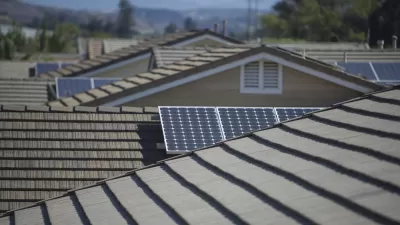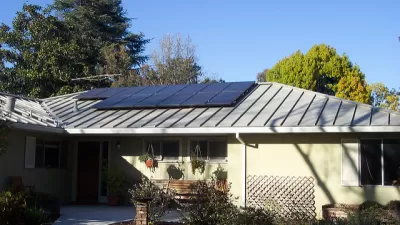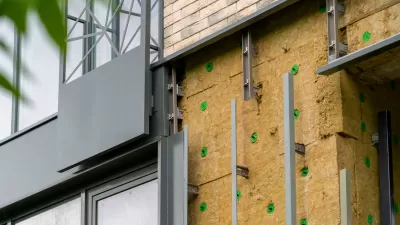The California Energy Commission will decide on new energy standards for residential construction this week.

"Now, California is on the verge of making solar standard on virtually every new home built in the Golden State," reports Jeff Collins.
The California Energy Commission will vote next week on new energy standards mandating solar panels for most new homes starting in 2020.
The decision to require solar marks a departure from a potential standard that requires net zero energy standards. Collins includes a discussion of the distinction between these two policy paths.
As for the details of the new energy standards, Collins reports: "The new solar mandate would apply to all houses, condos and apartment buildings up to three stories tall that obtain building permits after Jan. 1, 2020." There are exceptions, which Collins lists in the article.
Another important angle for the new energy requirements are the additional cost solar arrays and other features of the proposed energy standard will add to housing construction. "The new energy standards add about $25,000 to $30,000 to the construction costs compared with homes built to the 2006 code," according to estimates cited in the article.
FULL STORY: California to become first U.S. state mandating solar on new homes

Alabama: Trump Terminates Settlements for Black Communities Harmed By Raw Sewage
Trump deemed the landmark civil rights agreement “illegal DEI and environmental justice policy.”

Planetizen Federal Action Tracker
A weekly monitor of how Trump’s orders and actions are impacting planners and planning in America.

The 120 Year Old Tiny Home Villages That Sheltered San Francisco’s Earthquake Refugees
More than a century ago, San Francisco mobilized to house thousands of residents displaced by the 1906 earthquake. Could their strategy offer a model for the present?

LA’s Tree Emergency Goes Beyond Vandalism
After a vandal destroyed dozens of downtown LA trees, Mayor Karen Bass vowed to replace them. Days later, she slashed the city’s tree budget.

Sacramento Leads Nation With Bus-Mounted Bike Lane Enforcement Cameras
The city is the first to use its bus-mounted traffic enforcement system to cite drivers who park or drive in bike lanes.

Seattle Voters Approve Social Housing Referendum
Voters approved a corporate tax to fund the city’s housing authority despite an opposition campaign funded by Amazon and Microsoft.
Urban Design for Planners 1: Software Tools
This six-course series explores essential urban design concepts using open source software and equips planners with the tools they need to participate fully in the urban design process.
Planning for Universal Design
Learn the tools for implementing Universal Design in planning regulations.
Ada County Highway District
Clanton & Associates, Inc.
Jessamine County Fiscal Court
Institute for Housing and Urban Development Studies (IHS)
City of Grandview
Harvard GSD Executive Education
Toledo-Lucas County Plan Commissions
Salt Lake City
NYU Wagner Graduate School of Public Service





























